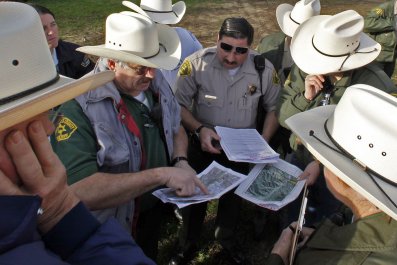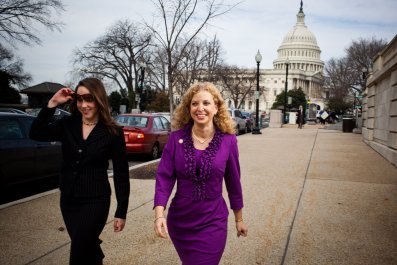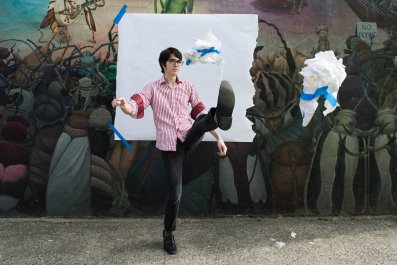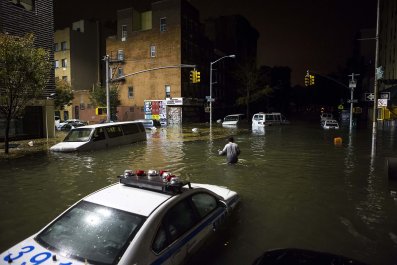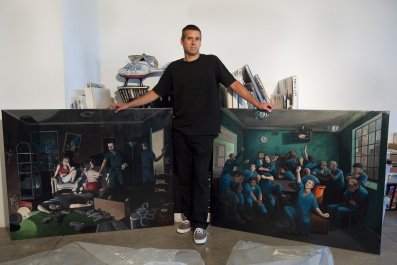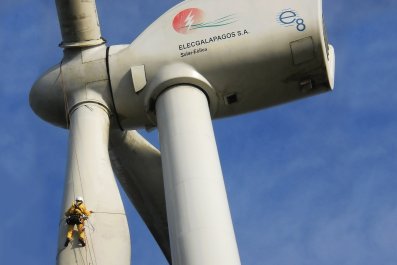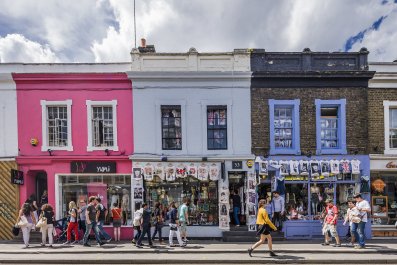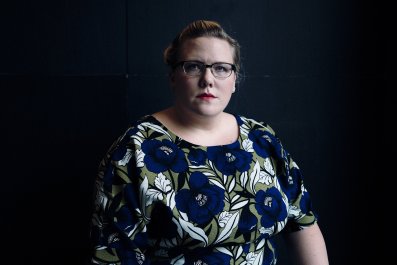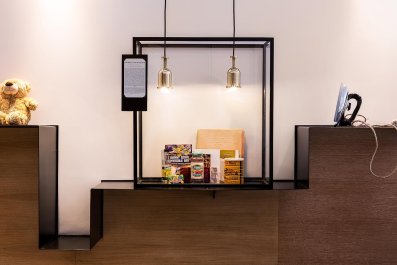Bill Wetzen built a good house. It was a bit small—two little rooms and a bigger one, with a skinny greenhouse running along one side—but exactly to his taste, and with two square windows looking out over a lake rimmed in black spruce trees. The lake remained frozen most of the year, a picture-postcard view of interior Alaska, and Wetzen had his little slice of great northern paradise.
But that was 15 years ago. Then the house started steadily lurching, first a few inches a year, then a few feet, directly into the lake. Or rather, the lake was growing, swallowing Wetzen's house in increments, warping the floor, breaking each window frame, until the entire structure pitched forward like a sprinter on starting blocks.
Stepping into the house on a brisk March evening induced a small shiver of vertigo. My first step was lower than it should have been, and my second was lower than that. Wetzen loosed a 10-pound barbell from behind a door to show me how it could roll downhill across the floor of his bedroom, toward the lake. "That used to be level," he says, then smirks, and there was glint of a silver hoop hanging from his left ear. Of course he built it level. But the house started tilting almost immediately after it was completed, and the conundrum has taken on an air of the tragicomic. This was a replacement house—a previous version was burned to the ground by some teenagers. When he rebuilt, he used twice the number of vertical studs necessary; even if he couldn't prevent his new house from going up in flames, he could at least build it strong enough to withstand the wind and snow and small earthquakes common here. But those extra studs won't keep the ground in place or the lake from growing. "Everything is going to go right into the lake. I'd say by this summer." He made a motion like a car careening off a cliff with his hands. Splat. "And I'm just the canary in the coal mine."
Beneath Wetzen's house, and in great swaths of land across much of Alaska's vast central and northern interior, the past decade of too-warm winters has unlocked organic material that's been trapped in icy ground for some 30,000 years. That ground is made of permafrost: many yards of mammoth bones, grasses, soil and other detritus frozen when this land was steppe tundra, ice-cold all year round. Now that permafrost is thawing. The land, losing its ice content, is receding. Spindly black spruce trees, the telltale arboreal species of permafrost area, are pitched at odd, drunken angles in places where the thawing ground beneath them has sunken or heaved. The meltwater from that ice is welling up, forming small lakes that gradually become bigger as they melt the permafrost beneath them. A significant portion of the lake behind Wetzen's house was a forest 50 years ago. The two-lane highway in front undulates abruptly in places where ice wedges underground have thawed. The locals call them "permafrost bumps," and the road needs repaving every few years.
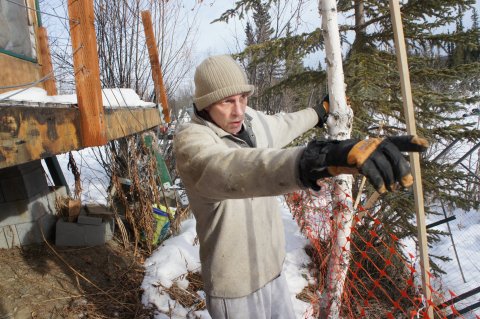
What's happening today really started about 22,000 years ago, when the world began to warm at the end of the last Ice Age. When much of the far north was covered in glaciers, central-interior Alaska was an oasis for mammals that grazed on the area's tundra grasses. Then the climate began to warm, and the icy layers of permafrost already under the grassy tundra, which never used to thaw, thoroughly melted during the summer months, causing the ground to subside and meltwater to fill the depressions, forming lakes and pools. All that melting permafrost pushed greenhouse gases into the atmosphere, accelerating warming, much as it does today. In the newly soggy terrain, plants drowned and habitats changed, subsequently starving the animals, which died en masse. Each winter during this period, the lakes and pools formed from all that meltwater abruptly froze again, locking in the organic material before microbes had a chance to decompose it. This happened season after season for centuries while the world transitioned to a temperate climate, building thousands of years' worth of permafrost, layers of grass and soil and mammoth bones locked in ice. By the end, the stuff lay under roughly 20 percent of the Earth's surface. Since then, it's made a fairly stable ground for the houses and roads humans built over it—until we started dramatically warming up the planet.
Discussions of global warming often center on the release of greenhouse gases like carbon into the atmosphere, mostly from burning fossil fuels. There's talk of "leaving it in the ground," locking potential gases up in benign obscurity as untapped coal or oil reserves, but rarely does one see carbon slowly and steadily unlocking itself. In the Goldstream Valley in central Alaska, you can see it almost everywhere you look.
But in one spot, that carbon is still in suspended animation. In the mid-1960s, as Cold War fears ramped up, the U.S. Army bored a tunnel directly through a hillside down the road from Wetzen's house, about 10 miles north of downtown Fairbanks, to research whether permafrost might be a good place to hide heavy weapons. Now the tunnel, kept cold year-round, is a treasure chest of research material for scientists who come to scrape off bits of ice or grass from 20,000, 30,000 and 40,000 years ago. Mammoth femurs and tusks jut out from its walls, and in one place, a tuft of grass, first buried some 20,000 years ago, dangles in the dark, still green with chlorophyll that never had a chance to degrade. There is the frozen carbon, locked in place. Should this tunnel warm, that grass and all the rest would begin the rapid cycle of decomposition, releasing all its stores of carbon into the atmosphere. That's already happening aboveground.
Worse yet, when permafrost thaws beneath a lake, where oxygen is scarce, the microbes decompose the organic material and convert it to methane gas instead of carbon dioxide. Methane is an extraordinarily potent greenhouse gas, with up to 25 times the warming power of carbon dioxide.
None of the permafrost thawing beneath millions of lakes across the Arctic is accounted for in global predictions about climate change—it's "a gap in our climate modeling," says Katey Walter Anthony, a University of Alaska Fairbanks researcher who studies permafrost thaw across Alaska and Siberia. She's become famous in certain circles for finding methane bubbling up beneath the ice in frozen-over permafrost lakes, cutting a hole ice-fishing style and lighting the highly flammable gas on fire, sending up a column of flames 10 feet high. But most of the time, Walter Anthony is flying between dozens of Arctic lakes, lowering tiny handmade rigs fashioned from plastic valves, fishing line and 2-liter Coke bottles into holes cut into the ice, to capture and count how much methane is bubbling up.
On a crisp evening in March, Walter Anthony knelt with two research assistants on the ice a few dozen feet from Wetzen's house. She's been coming here to take samples since 2003, and the shore of the lake nearest to his doomed house has grown about 3 feet in diameter each of those years. Today, she was teaching one of the assistants how to take methane samples with the homemade rig. The two fiddled with the valves, gloved hands in icy water, slowly easing bubbles of methane into tiny glass bottles underwater and capping them with rubber stoppers. A rubber duck was tied to the Coke bottle with fishing line, serving as a buoy and keeping the rig from sinking to the bottom of the lake. Within a few minutes, the freezing water was too cold for the assistant. Walter Anthony kept her hands in until they got their sample.
Without a lot more data, there's no way to know for sure how much methane is escaping from lakes like these globally. But according to the latest estimates, published last year in Biogeosciences, thawing beneath lakes in yedoma permafrost—the oldest, most carbon-rich type of permafrost found in Alaska and Siberia—could, by 2100, increase the amount of methane accumulated in the Earth's atmosphere by as much as 2.6 billion metric tons. By 2300, that could spike to 10 billion metric tons. Before 2000, yedoma permafrost hadn't thawed enough to begin forming these methane lakes. Now there's no looking back. "It's like the food for microbes has been locked away in the freezer for 30,000 years," Walter Anthony says, "and now the freezer door is open." The degree of warming that implies is catastrophic. "The methane causes climate warming, which causes more permafrost to thaw, which causes more gas to be produced, which causes more warming, so you get a positive feedback loop."
Back at his house, Wetzen wore two pairs of sweatpants layered against the 7-degree weather. He moved here nearly three decades ago, from Buffalo, New York, to open a Burger King on the Air Force base nearby. He was forced to resign shortly after and found other work. "It was before 'don't ask, don't tell' ended, and I told. It might not have mattered in the Lower 48, because I was a civilian, but it mattered here," he says, shrugging, moving around the house to show me a new sinkhole he'd just found. "See? Look—this is all shearing off. This is brand-new. Wow." A piling beneath the house looked like a stick of butter melting into the soil. Another was pitched at an angle like a loose tooth. Wetzen army-crawled under the house and found another two new sinkholes. "Well, would you take a look at that."
This past winter, the Arctic was preposterously warm: Snow had to be imported to Anchorage for the ceremonial start to the Iditarod, and in Fairbanks, much farther north, a day didn't hit minus-40 degrees, when there should have been many. Conversation about the weather around here is not small talk; it is vital, and locals across the political spectrum are dumbfounded about what is happening to their land, their communities. Still, Wetzen feels a deleterious gap between the shared shock about the warming weather and how local institutions are responding—or rather, not responding. His insurance company refused to pay for any damage to the house, and he says the municipal government hasn't helped either. He figures he lost $80,000 in that house. His mother died recently and left him enough money to build another home a few hundred yards away, on land he had thoroughly vetted for long-term stability. It's just a matter of time, he figures, until the lake expands all the way into the road. Maybe then the majority-Republican state government—and his neighbors—will stop being in denial about what it really means to live in a too-warm Alaska.
"I encounter people who don't believe in climate change every day of the week. I just tell them they might feel differently if it were happening to them," he says. Despite all the setbacks, Wetzen is happy to have made his life in Alaska. "It's very comfortable here. I love having the opportunity to do what I want on my piece of property. I loved being able to build the house I wanted to build," he says, then pauses. "Well, houses."




